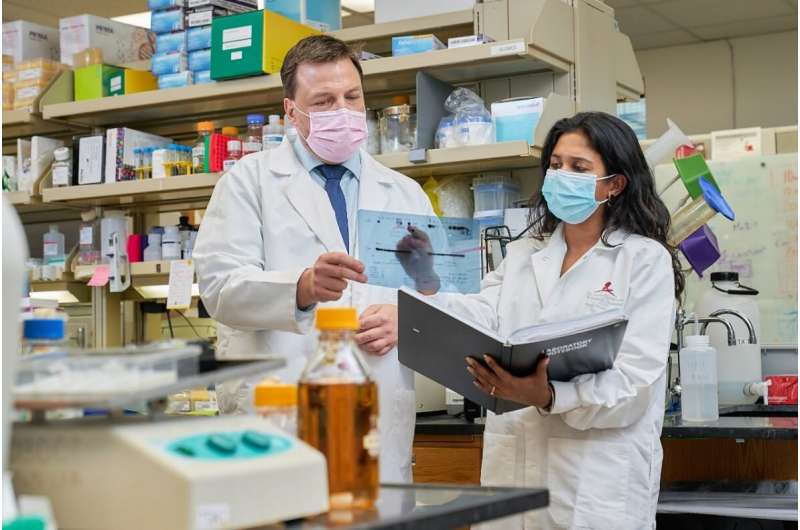
Researchers have discovered a battle waged within the blood systems of children who inherit mutations in the genes SAMD9 and SAMD9L. The outcomes have life-or-death consequences for patients. Investigators are working to learn how to influence the results.
St. Jude Children’s Research Hospital scientists led the research in collaboration with the European Working Group on MDS in Childhood. The results appear today in Nature Medicine.
The goal was to better understand the role SAMD9 and SAMD9L germline (inherited) mutations play in pediatric myelodysplastic syndromes or MDS. Pediatric MDS is a group of rare disorders in which the bone marrow fails to make enough healthy blood cells. It is also associated with an increased risk for leukemia.
The scientists found evidence in almost two-third of patients with SAMD9 and SAMD9L mutations that their blood systems had worked to suppress expression of the mutant genes. Overall, the SAMD9 and SAMD9L mutations were found in 8% of pediatric MDS patients. That makes the mutations, along with others in the GATA2 gene, the most common cause of MDS in children.
“The genetic rescue functioned as a form of natural gene therapy with the potential to cure patients with SAMD9 or SAMD9L mutations and reduce their risk of developing leukemia,” said corresponding author Marcin Wlodarski, M.D., Ph.D., of the St. Jude Department of Hematology. “The dream moving forward is to understand and replicate the process in patients’ cells.”
Tracking the SAMD9 and SAMD9L risk
Mutant SAMD9 and SAMD9L proteins suppress cell growth and cause changes in bone marrow. But until now, questions remained about their role and function in MDS, including on treatment outcomes.
“Working with a large international cohort of well characterized patients gives us a great opportunity to understand the treatment outcomes and recognize new clinical phenotypes and genetic associations in these patients. For rare diseases such as SAMD9 and SAMD9L, this would not be possible with single-center cohorts,” said first author Sushree Sahoo, Ph.D., a St. Jude postdoctoral fellow in the Wlodarski laboratory.
For this study, researchers analyzed 669 children and adolescents in the world’s largest registry of pediatric MDS and identified 67 with germline SAMD9 and SAMD9L mutations. Co-author Charlotte Niemeyer, M.D., of the University of Freiburg, Germany, and the European Working Group of MDS in Childhood established the registry more than 20 years ago.
A closer look revealed that 61% of patients had evidence of genetic rescue, what Wlodarski called natural gene therapy. That is the highest rate of genetic rescue of hematopoietic system reported in a human disease. In some cases, the process resulted in benign SAMD9 and SAMD9L alterations that were associated with decreased risk of leukemia and MDS and had the potential to cure the blood abnormalities. Others, particularly alterations such as the loss of chromosome 7, were associated with increased leukemia risk.
Battle of the clones revealed
A single-cell DNA sequencing method developed for this study revealed that genetic rescue led to competition among multiple blood clones.
“The method revealed a battle of the clones playing out in patients as clones with different origins compete for dominance in the blood system,” Wlodarski said. For example, one patient had blood cells from four different genetic clones, including a high-risk clone and two that were benign, or what the authors call “adaptive.”
Researchers also used this method to track how different clones in bone marrow fared over time based on their percentage of the blood system. This method can look at hundreds of mutations in single cells and may help identify patients who will do well without the risk and expense of bone marrow transplantation.
Next steps
“Our studies lay the groundwork for research to explore in detail how genetic rescue occurs and how we might be able to manipulate SAMD9 and SAMD9L genes and use this knowledge to facilitate gene therapy that rescues patients,” Wlodarski said.
But an important question remains open: What are the exact cellular consequences of the mutations that researchers found? Wlodarski noted that Jeffery Klco, M.D., Ph.D., of the St. Jude Department of Pathology, recently published research showing that mutations in these genes can affect the protein synthesis.
“This might help us better understand which pathways are affected in patients’ cells,” Wlodarski said.
Source: Read Full Article